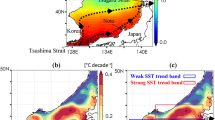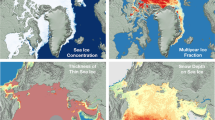Abstract
High Frequency (HF) radar current data is assimilated into a shelf sea circulation model based on optimal interpolation (OI) method. The purpose of this work is to develop a real-time computationally highly efficient assimilation method to improve the forecast of shelf current. Since the true state of the ocean is not known, the specification of background error covariance is arduous. Usually, it is assumed or calculated from an ensemble of model states and is kept in constant. In our method, the spatial covariances of model forecast errors are derived from differences between the adjacent model forecast fields, which serve as the forecast tendencies. The assumption behind this is that forecast errors can resemble forecast tendencies, since variances are large when fields change quickly and small when fields change slowly. The implementation of HF radar data assimilation is found to yield good information for analyses. After assimilation, the root-mean-square error of model decreases significantly. Besides, three assimilation runs with variational observation density are implemented. The comparison of them indicates that the pattern described by observations is much more important than the amount of observations. It is more useful to expand the scope of observations than to increase the spatial interval. From our tests, the spatial interval of observation can be 5 times bigger than that of model grid.
Similar content being viewed by others
References
Backhaus, J., 1985. A three-dimensional model for the simulation of shelf sea dynamics. Ocean Dynamics, 38(4): 165–187.
Barrick, D., 1978. HF radio oceanography review. Boundary-Layer Meteorology, 13(1): 23–43.
Barrick, D., Evans, M., and Weber, B., 1977. Ocean surface currents mapped by radar. Science, 198(4313): 138–144.
Barth, A., Alvera-Azcarate, A., and Weisberg, R., 2008. Assimilation of high-frequency radar currents in a nested model of the west Florida shelf. Journal of Geophysical Research, 113(C8), DOI: 10.1029/2007JC004585.
Breivik, R., and Saetra, R., 2001. Real time assimilation of HF radar currents into a coastal ocean model. Journal of Marine Systems, 28(3–4): 161–182.
Buehner, M., Houtekamer, P. L., Charette, C., and Mitchell, H. L., 2010. Intercomparison of variational data assimilation and the ensemble Kalman filter for global deterministic NWP. Part I: Description and single-observation experiments. Monthly Weather Review, 138(5): 1550–1566.
Chen, X. E., and Zhan, P., Chen, J. R., and Qian, H. B., 2011. Numerical study of current fields near the Changjiang Estuary and impact of Quick-EnKF assimilation. Acta Oceanologica Sinica, 30(5): 33–44.
Gurgel, K., and Antonischki, G., 1997. Measurement of surface current fields with high spatial resolution by the HF radar WERA. Geoscience and Remote Sensing, 1997. IGARSS’97. Remote Sensing-A Scientific Vision for Sustainable Development, 1997 IEEE International Vol. 4, 1820–1822.
Gurgel, K., Antonischki, G., Essen, H., and Schlick, T., 1999. Wellen Radar (WERA): A new ground-wave HF radar for ocean remote sensing. Coastal Engineering, 37(3–4): 219–234.
Jackson, D. R., Keil, M., and Devenish, B. J., 2008. Use of Canadian quick covariances in the met office data assimilation system. Quarterly Journal of Royal Meteorological Society, 134: 1567–1582.
Kalnay, E., Kanamitsu, M., Kistler, R., Collins, W., Deaven, D., Gandin, L., Iredell, M., Saha, S., White, G., Woollen, J., and Zhu, Y., 1996. The NCEP/NCAR 40-year reanalysis project. Bulletin of the American Meteorological Society, 77(3): 437–471.
Krishnamurthy, A., Cobb, L., Mandel, J., and Beezley, J., 2010. Bayesian tracking of emerging epidemics using ensemble optimal statistical interpolation. 2010 Joint Statistical Meetings, July 31–August 5, 2010, Vancouver, Canada.
Kurapov, A., Egbert, G., Miller, R., and Allen, J., 2002. Data assimilation in a baroclinic coastal ocean model: Ensemble statistics and comparison of methods. Monthly Weather Review, 130(4): 1009–1025.
Law, K. J. H., and Stuart, A. M., 2012. Evaluating data assimilation algorithms. Monthly Weather Review, 140: 3757–3782.
Levitus, S., Boyer, T., and Antonov, J., 1994. World Ocean Atlas 1994. Volume 5. Interannual Variability of Upper Ocean Thermal Structure. Technique report, PB-95-270120/XAB, National Environmental Satellite, Data, and Information Service, Washington, DC, 176pp.
Lewis, J., Shulman, I., and Blumberg, A., 1998. Assimilation of CODAR observations into ocean models. Continental Shelf Research, 18: 541–559.
Loyola, D. G., and Coldewey-Egbers, M., 2012. Multi-sensor data merging with stacked neural networks for creation of satellite long-term climate data records. EURASIP Journal on Advances in Signal Processing, 2012: 91.
Oke, P., Allen, J., Miller, R., Egbert, G., and Kosro, P., 2002. Assimilation of surface velocity data into a primitive equation coastal ocean model. Journal of Geophysical Research, 107, 3122, DOI: 10.1029/2000JC000511.
Paduan, J., and Shulman, I., 2004. HF radar data assimilation in the Monterey Bay area. Journal of Geophysical Research, 109(C7), DOI: 10.1029/2003JC001949.
Pohlmann, T., 1996a. Calculating the development of the thermal vertical stratification in the North Sea with a three-dimensional baroclinic circulation model. Continental Shelf Research, 16(2): 163–194.
Pohlmann, T., 1996b. Predicting the thermocline in a circulation model of the North seapart I: Model description, calibration and verification. Continental Shelf Research, 16(2): 131–146.
Pohlmann, T., 2006. A meso-scale model of the central and southern North Sea: Consequences of an improved resolution. Continental Shelf Research, 26(19): 2367–2385.
Polavarapu, S., Ren, S., Rochon, Y., Sankey, D., Ek, N., Koshyk, J., and Tarasick, D., 2005. Data assimilation with the Canadian middle atmosphere model. Atmosphere-Ocean, 43(1): 77–100.
Scott, R., Allen, J., Egbert, G., and Miller, R., 2000. Assimilation of surface current measurements in a coastal ocean model. Journal of Physical Oceanography, 30(9): 2359–2378.
Smagorinsky, J., 1963. General circulation experiments with the primitive equations. I. The basic experiment. Monthly Weather Review, 91: 99–164.
Author information
Authors and Affiliations
Corresponding author
Rights and permissions
About this article
Cite this article
Xu, J., Huang, J., Gao, S. et al. Assimilation of high frequency radar data into a shelf sea circulation model. J. Ocean Univ. China 13, 572–578 (2014). https://doi.org/10.1007/s11802-014-2224-2
Received:
Revised:
Accepted:
Published:
Issue Date:
DOI: https://doi.org/10.1007/s11802-014-2224-2




